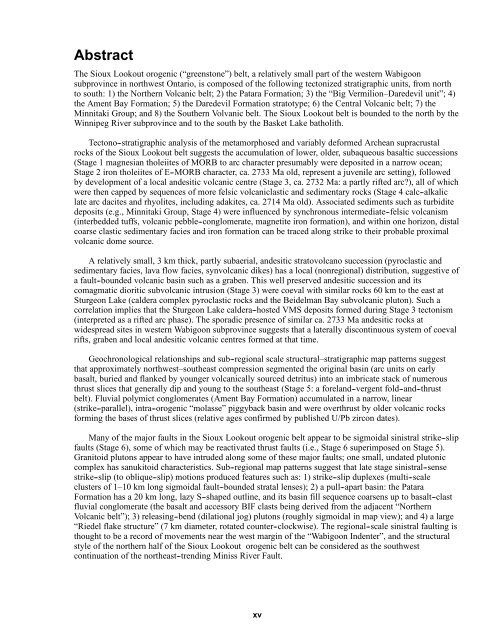Regional Geology, Sioux Lookout Orogenic Belt - Geology Ontario
Regional Geology, Sioux Lookout Orogenic Belt - Geology Ontario
Regional Geology, Sioux Lookout Orogenic Belt - Geology Ontario
Create successful ePaper yourself
Turn your PDF publications into a flip-book with our unique Google optimized e-Paper software.
Abstract<br />
The <strong>Sioux</strong> <strong>Lookout</strong> orogenic (“greenstone”) belt, a relatively small part of the western Wabigoon<br />
subprovince in northwest <strong>Ontario</strong>, is composed of the following tectonized stratigraphic units, from north<br />
to south: 1) the Northern Volcanic belt; 2) the Patara Formation; 3) the “Big Vermilion–Daredevil unit”; 4)<br />
the Ament Bay Formation; 5) the Daredevil Formation stratotype; 6) the Central Volcanic belt; 7) the<br />
Minnitaki Group; and 8) the Southern Volvanic belt. The <strong>Sioux</strong> <strong>Lookout</strong> belt is bounded to the north by the<br />
Winnipeg River subprovince and to the south by the Basket Lake batholith.<br />
Tectono--stratigraphic analysis of the metamorphosed and variably deformed Archean supracrustal<br />
rocks of the <strong>Sioux</strong> <strong>Lookout</strong> belt suggests the accumulation of lower, older, subaqueous basaltic successions<br />
(Stage 1 magnesian tholeiites of MORB to arc character presumably were deposited in a narrow ocean;<br />
Stage 2 iron tholeiites of E--MORB character, ca. 2733 Ma old, represent a juvenile arc setting), followed<br />
by development of a local andesitic volcanic centre (Stage 3, ca. 2732 Ma: a partly rifted arc?), all of which<br />
were then capped by sequences of more felsic volcaniclastic and sedimentary rocks (Stage 4 calc--alkalic<br />
late arc dacites and rhyolites, including adakites, ca. 2714 Ma old). Associated sediments such as turbidite<br />
deposits (e.g., Minnitaki Group, Stage 4) were influenced by synchronous intermediate--felsic volcanism<br />
(interbedded tuffs, volcanic pebble--conglomerate, magnetite iron formation), and within one horizon, distal<br />
coarse clastic sedimentary facies and iron formation can be traced along strike to their probable proximal<br />
volcanic dome source.<br />
A relatively small, 3 km thick, partly subaerial, andesitic stratovolcano succession (pyroclastic and<br />
sedimentary facies, lava flow facies, synvolcanic dikes) has a local (nonregional) distribution, suggestive of<br />
a fault--bounded volcanic basin such as a graben. This well preserved andesitic succession and its<br />
comagmatic dioritic subvolcanic intrusion (Stage 3) were coeval with similar rocks 60 km to the east at<br />
Sturgeon Lake (caldera complex pyroclastic rocks and the Beidelman Bay subvolcanic pluton). Such a<br />
correlation implies that the Sturgeon Lake caldera--hosted VMS deposits formed during Stage 3 tectonism<br />
(interpreted as a rifted arc phase). The sporadic presence of similar ca. 2733 Ma andesitic rocks at<br />
widespread sites in western Wabigoon subprovince suggests that a laterally discontinuous system of coeval<br />
rifts, graben and local andesitic volcanic centres formed at that time.<br />
Geochronological relationships and sub--regional scale structural–stratigraphic map patterns suggest<br />
that approximately northwest–southeast compression segmented the original basin (arc units on early<br />
basalt, buried and flanked by younger volcanically sourced detritus) into an imbricate stack of numerous<br />
thrust slices that generally dip and young to the southeast (Stage 5: a foreland--vergent fold--and--thrust<br />
belt). Fluvial polymict conglomerates (Ament Bay Formation) accumulated in a narrow, linear<br />
(strike--parallel), intra--orogenic “molasse” piggyback basin and were overthrust by older volcanic rocks<br />
forming the bases of thrust slices (relative ages confirmed by published U/Pb zircon dates).<br />
Many of the major faults in the <strong>Sioux</strong> <strong>Lookout</strong> orogenic belt appear to be sigmoidal sinistral strike--slip<br />
faults (Stage 6), some of which may be reactivated thrust faults (i.e., Stage 6 superimposed on Stage 5).<br />
Granitoid plutons appear to have intruded along some of these major faults; one small, undated plutonic<br />
complex has sanukitoid characteristics. Sub--regional map patterns suggest that late stage sinistral--sense<br />
strike--slip (to oblique--slip) motions produced features such as: 1) strike--slip duplexes (multi--scale<br />
clusters of 1–10 km long sigmoidal fault--bounded stratal lenses); 2) a pull--apart basin: the Patara<br />
Formation has a 20 km long, lazy S--shaped outline, and its basin fill sequence coarsens up to basalt--clast<br />
fluvial conglomerate (the basalt and accessory BIF clasts being derived from the adjacent “Northern<br />
Volcanic belt”); 3) releasing--bend (dilational jog) plutons (roughly sigmoidal in map view); and 4) a large<br />
“Riedel flake structure” (7 km diameter, rotated counter--clockwise). The regional--scale sinistral faulting is<br />
thought to be a record of movements near the west margin of the “Wabigoon Indenter”, and the structural<br />
style of the northern half of the <strong>Sioux</strong> <strong>Lookout</strong> orogenic belt can be considered as the southwest<br />
continuation of the northeast--trending Miniss River Fault.<br />
xv

















